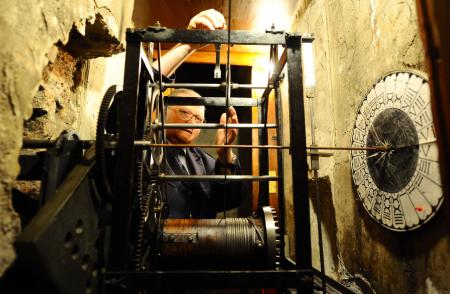Restoration of the clock in the Florence Duomo painted by Paolo Uccello
By MyWatch
The restored mechanism of the great clock of the Florence Duomo is officially presented in Florence. It is known as the “clock of Paolo Uccello”, so named after the great Renaissance artist responsible for the sophisticated decoration of the dial in 1433. Set in the interior facade above the central door, in a space concealed from sight, the clock is one of the very few in the world which shows the time based on the “Italic Hours” system.
Opera di Santa Maria del Fiore, in agreement with Officine Panerai, entrusted the restoration to two of the greatest experts in the field, Professor Andrea Palmieri and Professor Ugo Pancani, of the Centro Studi per il Restauro di Orologi of the I.S.I.S Leonardo da Vinci in Florence. The restoration, which has put the mechanism of the clock back in working order, was made possible thanks to the contribution of Officine Panerai, the House of haute horlogerie sports watches which was founded in Florence in 1860 and has its own historic boutique a few yards from the Duomo in the Archbishop’s Palace, facing the Baptistery.
The clock of the Florence Duomo is unique in the world not only because of its remarkable position and the painting of its dial but also because it keeps Italic Time, a way of measuring time which in antiquity was known as “Julian Time” (after Julius Caesar, who in 46 bc introduced the Julian Calendar developed by Sosigenes of Alexandria). Unlike modern dials, Italic Time – also known as “Ave Maria” or “Italian Time” – has a single hand moving round the dial anti-clockwise and the 24th hour is not midnight but the hour of sunset, from which the counting of the hours starts. Therefore the clock must be adjusted throughout the year so that the last hour of the day is always the hour of sunset.
As Giorgio Vasari wrote (“Paolo painted the hours on the dial above the main door inside the church, with four heads in the corners painted in fresco”), it was the Florentine painter Paolo Uccello (born Paolo di Dono, 1397-1475) who painted the dial of the clock which is almost seven metres in diameter. On the dial the great artist painted the 24 hours in Roman numerals in ascending order, but anti-clockwise. In the four corners he painted four mysterious heads of men with haloes who seem to be looking downwards towards the centre: according to some people they are prophets while others believe they are the four evangelists.
The original mechanism of the clock was built in 1443 by the Florentine clockmaker Angelo di Niccolò but we do not have any information about how it operated: it was probably fitted with a system of weights and counter-weights, some of which have been found within the Duomo. A few decades after its construction, the mechanism needed some repairs. This task was entrusted to the Della Volpaia family of clockmakers and scientists : first in 1497 to Lorenzo – the creator of the famous Planetary Clock – and then to his son Camillo who rebuilt it almost completely between 1546 and 1547. Over the years the clock was repaired several times until 1688 when the Opera di Santa Maria del Fiore, inspired by the research carried out by Galileo and Huygens, decided to replace the old mechanism with a new one fitted with a pendulum. This ran until 1761 when the Florentine clockmaker Giuseppe Borgiacchi again replaced the mechanism with a new one which is still working today. It was then that Paolo Uccello’s dial was changed from 24 hours to 12 hours and the original hand was replaced. It was only 40 years ago that the clock was restored to its original appearance and characteristics, thanks to a restoration which exposed the magnificent original dial and restored the ancient operation of the mechanism with the hand which completed one turn in 24 hours, starting at the time of sunset and moving anti-clockwise.
In recent years further restoration has been needed to solve some problems with the mechanism which threatened the operation of the clock: the presence of harmful substances (a build-up of iron oxide and dirt), deformation, deterioration and serious wear of the pivots of the shafts, the shaft holes, the anchor pallets and the pinions. The restoration started with the dismantling of the clock and an initial cleaning to remove the harmful substances. Then all the individual components were overhauled and finally the mechanism was reassembled and regulated.
For over twenty years the weekly adjustment of the sunset time of the Florence Duomo clock and its winding have been the responsibility of two custodians of the Opera di Santa del Fiore, Lucio Bigi and Mario Mureddu, who have also written the only book on the subject. Before them this task had been carried out by other members of the Opera throughout the centuries. In Florence “Ave Maria Time” is marked by the sound of the bells of Giotto’s campanile which indicate the time six times during the day, three times in the morning (at 7, 11.30 and 12.00) and three times in the afternoon at times which vary during the year: one hour before sunset, at sunset (or XXIV hours, when the Ave Maria was recited or Vespers celebrated) and one hour after sunset, the “Hour of the night’. As Bigi and Mureddu wrote in their book, “The sound of the bells at XXIV hours was to warn people working in the fields to return home, before the gates of the city were closed. And the bells ringing at 11.30, “the Hour of Mercy”, indicated to the Fratelli della Compagnia that it was time to make their charitable rounds to the needy of the city.”
